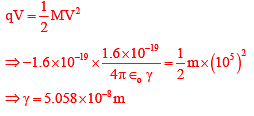Electronics and Communication Engineering (ECE) Exam > Electronics and Communication Engineering (ECE) Questions > An electron (q1) is moving in free space with...
Start Learning for Free
An electron (q1) is moving in free space with velocity 105 m/s towards a stationary electron (q2) far away. The closest distance that this moving electron gets to the stationary electron before the repulsive force diverts its path is ___________ ×10-8m.
[Given, mass of electron m = 9.11×10-31kg, charge of electron e = -1.6×10-19C , and permittivity 
Correct answer is '4.55 to 5.55'. Can you explain this answer?
| FREE This question is part of | Download PDF Attempt this Test |
Verified Answer
An electron (q1) is moving in free space with velocity 105 m/s towards...
Work done due to field and external agent must be zero


|
Explore Courses for Electronics and Communication Engineering (ECE) exam
|

|
Similar Electronics and Communication Engineering (ECE) Doubts
An electron (q1) is moving in free space with velocity 105 m/s towards a stationary electron (q2) far away. The closest distance that this moving electron gets to the stationary electron before the repulsive force diverts its path is ___________ ×10-8m.[Given, mass of electron m = 9.11×10-31kg, charge of electron e = -1.6×10-19C , and permittivity Correct answer is '4.55 to 5.55'. Can you explain this answer?
Question Description
An electron (q1) is moving in free space with velocity 105 m/s towards a stationary electron (q2) far away. The closest distance that this moving electron gets to the stationary electron before the repulsive force diverts its path is ___________ ×10-8m.[Given, mass of electron m = 9.11×10-31kg, charge of electron e = -1.6×10-19C , and permittivity Correct answer is '4.55 to 5.55'. Can you explain this answer? for Electronics and Communication Engineering (ECE) 2024 is part of Electronics and Communication Engineering (ECE) preparation. The Question and answers have been prepared according to the Electronics and Communication Engineering (ECE) exam syllabus. Information about An electron (q1) is moving in free space with velocity 105 m/s towards a stationary electron (q2) far away. The closest distance that this moving electron gets to the stationary electron before the repulsive force diverts its path is ___________ ×10-8m.[Given, mass of electron m = 9.11×10-31kg, charge of electron e = -1.6×10-19C , and permittivity Correct answer is '4.55 to 5.55'. Can you explain this answer? covers all topics & solutions for Electronics and Communication Engineering (ECE) 2024 Exam. Find important definitions, questions, meanings, examples, exercises and tests below for An electron (q1) is moving in free space with velocity 105 m/s towards a stationary electron (q2) far away. The closest distance that this moving electron gets to the stationary electron before the repulsive force diverts its path is ___________ ×10-8m.[Given, mass of electron m = 9.11×10-31kg, charge of electron e = -1.6×10-19C , and permittivity Correct answer is '4.55 to 5.55'. Can you explain this answer?.
An electron (q1) is moving in free space with velocity 105 m/s towards a stationary electron (q2) far away. The closest distance that this moving electron gets to the stationary electron before the repulsive force diverts its path is ___________ ×10-8m.[Given, mass of electron m = 9.11×10-31kg, charge of electron e = -1.6×10-19C , and permittivity Correct answer is '4.55 to 5.55'. Can you explain this answer? for Electronics and Communication Engineering (ECE) 2024 is part of Electronics and Communication Engineering (ECE) preparation. The Question and answers have been prepared according to the Electronics and Communication Engineering (ECE) exam syllabus. Information about An electron (q1) is moving in free space with velocity 105 m/s towards a stationary electron (q2) far away. The closest distance that this moving electron gets to the stationary electron before the repulsive force diverts its path is ___________ ×10-8m.[Given, mass of electron m = 9.11×10-31kg, charge of electron e = -1.6×10-19C , and permittivity Correct answer is '4.55 to 5.55'. Can you explain this answer? covers all topics & solutions for Electronics and Communication Engineering (ECE) 2024 Exam. Find important definitions, questions, meanings, examples, exercises and tests below for An electron (q1) is moving in free space with velocity 105 m/s towards a stationary electron (q2) far away. The closest distance that this moving electron gets to the stationary electron before the repulsive force diverts its path is ___________ ×10-8m.[Given, mass of electron m = 9.11×10-31kg, charge of electron e = -1.6×10-19C , and permittivity Correct answer is '4.55 to 5.55'. Can you explain this answer?.
Solutions for An electron (q1) is moving in free space with velocity 105 m/s towards a stationary electron (q2) far away. The closest distance that this moving electron gets to the stationary electron before the repulsive force diverts its path is ___________ ×10-8m.[Given, mass of electron m = 9.11×10-31kg, charge of electron e = -1.6×10-19C , and permittivity Correct answer is '4.55 to 5.55'. Can you explain this answer? in English & in Hindi are available as part of our courses for Electronics and Communication Engineering (ECE).
Download more important topics, notes, lectures and mock test series for Electronics and Communication Engineering (ECE) Exam by signing up for free.
Here you can find the meaning of An electron (q1) is moving in free space with velocity 105 m/s towards a stationary electron (q2) far away. The closest distance that this moving electron gets to the stationary electron before the repulsive force diverts its path is ___________ ×10-8m.[Given, mass of electron m = 9.11×10-31kg, charge of electron e = -1.6×10-19C , and permittivity Correct answer is '4.55 to 5.55'. Can you explain this answer? defined & explained in the simplest way possible. Besides giving the explanation of
An electron (q1) is moving in free space with velocity 105 m/s towards a stationary electron (q2) far away. The closest distance that this moving electron gets to the stationary electron before the repulsive force diverts its path is ___________ ×10-8m.[Given, mass of electron m = 9.11×10-31kg, charge of electron e = -1.6×10-19C , and permittivity Correct answer is '4.55 to 5.55'. Can you explain this answer?, a detailed solution for An electron (q1) is moving in free space with velocity 105 m/s towards a stationary electron (q2) far away. The closest distance that this moving electron gets to the stationary electron before the repulsive force diverts its path is ___________ ×10-8m.[Given, mass of electron m = 9.11×10-31kg, charge of electron e = -1.6×10-19C , and permittivity Correct answer is '4.55 to 5.55'. Can you explain this answer? has been provided alongside types of An electron (q1) is moving in free space with velocity 105 m/s towards a stationary electron (q2) far away. The closest distance that this moving electron gets to the stationary electron before the repulsive force diverts its path is ___________ ×10-8m.[Given, mass of electron m = 9.11×10-31kg, charge of electron e = -1.6×10-19C , and permittivity Correct answer is '4.55 to 5.55'. Can you explain this answer? theory, EduRev gives you an
ample number of questions to practice An electron (q1) is moving in free space with velocity 105 m/s towards a stationary electron (q2) far away. The closest distance that this moving electron gets to the stationary electron before the repulsive force diverts its path is ___________ ×10-8m.[Given, mass of electron m = 9.11×10-31kg, charge of electron e = -1.6×10-19C , and permittivity Correct answer is '4.55 to 5.55'. Can you explain this answer? tests, examples and also practice Electronics and Communication Engineering (ECE) tests.

|
Explore Courses for Electronics and Communication Engineering (ECE) exam
|

|
Suggested Free Tests
Signup for Free!
Signup to see your scores go up within 7 days! Learn & Practice with 1000+ FREE Notes, Videos & Tests.























